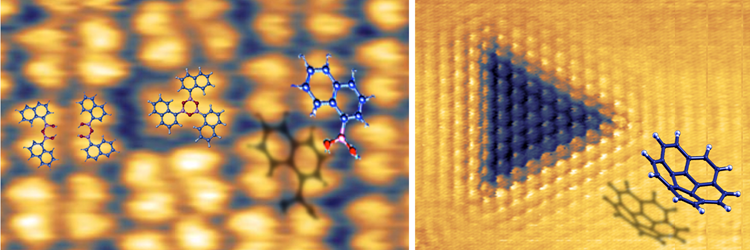

An IOM/Elettra laboratory of microscopy for the synthesis and modification of small organic molecules on metals and metal oxides to steer reactions and charge transport.
- The OSMOS laboratory for microscopy (joint project between CNR-IOM and Sincrotrone-Elettra, rif. Andrea Goldoni) is composed of three interconnected experimental chambers in Ultra-High Vacuum (UHV): i) variable temperature STM chamber (100-300 K), ii) sample preparation chamber (300-1110 K) equipped with LEED, quartz microbalance, sample holders with on-board thermocouple, iii) X-ray spectroscopy chamber equipped with an Al/Mg X-ray source PSP Tx-400 and a monochromatized Gamma Data VUV 5000 source (He I, II), which are coupled to a hemispherical (150mm) electron spectrometer with CCD detector, and a closed-circuit liquid He cryostat (11 K on sample) for in-situ XPS and angle-resolved UPS analysis.
- The project takes advantage of direct access to the Synchrotron beamline ALOISA (responsible Luca Floreano) for performing high resolution fast-photoemission, resonant photoemission and X-ray absorption spectroscopy (NEXAFS) at variable scattering and polarization geometries.
Instrumentation:
RL1: Morphological and structural characterization of self assembled layers of organic molecules, namely polyconjugated and heteroaromatic compounds (oligomers, polyacenes, perylenes, porphyrins and their derivatives). Study of the charge transfer and molecular bonding to the substrate, the on-surface molecular modifications, as well as the chemical interactions and linking in hetero-molecular systems, both in 2D and 2D+1 architectures.
RL2: Synthesis of 2D frameworks on surfaces, using small molecular precursors, aimed at modifying the chemical and morphological properties of the substrate. The main goal is to build 2D templates with specific chemical properties, able to selectively anchor guest species via molecular recognition.
The OSMOS lab is made available to public access through the NFFA network (www.nffa.eu). Preliminary contact with lab responsible (Luca Floreano) is mandatory before submitting a proposal.
- Elettra-Sincrotrone Trieste S.c.p.A. (Dr. Andrea Goldoni)
- Università di Trieste (Prof. Albano Cossaro, Dr. Valeria Lanzilotto)
- CNR-ICMATE, Padova (Dr. Andrea Vittadini)
- Università Statale di Milano (Prof. Guido Fratesi)
- Politecnico di Milano (Prof. Gianlorenzo Bussetti, Dr. Alberto Calloni)
- University of Ljubljana (Prof. Gregor Bavdek, Prof. Dean Cvetko, Dr. Gregor Kladnik)
- Peter Grünberg Institute, Jülich (Dr. Vitaliy Feyer)
- ICMM-CSIC, Madrid (Prof. Josè A. Martin-Gago, Dr. Maria F. Lopez-Facundo)
- CFM-CSIC/UPV-EHU, San Sebastian/Donostia (Dr. Celia Rogero)
- Hebrew University of Jerusalem (Prof. Elad Gross)